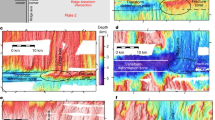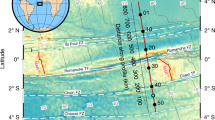Abstract
The presence of large earthquakes, east–west-striking folds and thrust faults in sediments, and east–west-striking undulations of wavelength 200 km in topography and gravity shows that the equatorial Indian Ocean is the locus of unusual deformation1,2,3,4,5,6,7,8. This deformation has been interpreted as a diffuse boundary between two tectonic plates9,10,11,12,13. Seismic stratigraphy and deep-sea drilling at two locations in the Bengal fan indicate that the deformation began 7.5–8.0 Myr ago3,14,15. Here, however, we show, using plate reconructions, that motion across this diffuse oceanic plate boundary began more than 10 Myr earlier than previously inferred and that the amount of north–south convergence across the boundary through the central Indian basin has been significantly greater than the convergence estimated from seismic profiles. The relative plate velocity accommodated across the central Indian basin has varied with time and has been as fast as ∼6 mm yr−1 — about half the separation rate of Earth's slowest-spreading mid-ocean ridge. The earliest interval of measurable motion, which began more than 18 Myr ago, may coincide with rapid denudation of the Tibetan plateau from ∼21 Myr to 15–17 Myr ( ref. 16). The present motion across the central Indian basin began no earlier than 11 Myr — following an earlier interval of slower motion from 18 to 11 Myr — and may have begun at ∼8 Myr, when the Tibetan plateau is thought to have attained its maximum elevation16,17.
This is a preview of subscription content, access via your institution
Access options
Subscribe to this journal
Receive 51 print issues and online access
$199.00 per year
only $3.90 per issue
Buy this article
- Purchase on Springer Link
- Instant access to full article PDF
Prices may be subject to local taxes which are calculated during checkout




Similar content being viewed by others
References
Stein, S. & Okal, E. A. Seismicity and tectonics of the Ninetyeast Ridge area: Evidence for internal deformation of the Indian plate. J. Geophys. Res. 83, 2233– 2245 (1978).
Weissel, J. K., Anderson, R. N. & Geller, C. A. Deformation of the Indo-Australian plate. Nature 287, 284–291 ( 1980).
Curray, J. R. & Munasinghe, T. Timing of intraplate deformation, northeastern Indian Ocean. Earth Planet. Sci. Lett. 94, 71–77 (1989).
Bull, J. M. & Scrutton, R. A. Seismic reflection images of intraplate deformation, Central Indian Ocean, and their tectonic significance. J. Geol. Soc. Lond. 149, 955– 966 (1992).
Chamot-Rooke, N., Jestin, F., de Voogd, B. & Phèdre Working Group Intraplate shortening in the central Indian Ocean determined from a 2100-km-long north-south deep seismic reflection profile. Geology 21, 1043–1046 (1993).
Jestin, F. Cinématique rigide et Déformations dans la Jonction Triple Afar et dans le Basin Indien Central.Thesis, Univ. Pierre et Marie Curie (Pari s 6)((1994)).
Van Orman, J., Cochran, J. R., Weissel, J. K. & Jestin, F. Distribution of shortening between the Indian and Australian plates in the central Indian Ocean. Earth Planet. Sci. Lett. 133, 35–46 (1995).
McAdoo, D. C. & Sandwell, D. T. Folding of oceanic lithosphere. J. Geophys. Res. 90, 8563– 8569 (1985).
Wiens, D. A.et al. Adiffuse plate boundary model for Indian Ocean tectonics. Geophys. Res. Lett. 12, 429–432 (1985).
Gordon, R. G., DeMets, C. & Argus, D. F. Kinematic constraints on distributed lithospheric deformation in the equatorial Indian Ocean from present motion between the Australian and Indian plates. Tectonics 9, 409– 422 (1990).
Royer, J.-Y. & Chang, T. Evidence for relative motions between the Indian and Australian plates during the last 20 Myr from plate tectonic reconstructions: Implications for the deformation of the Indo-Australian plate. J. Geophys. Res. 96, 11779– 11802 (1991).
DeMets, C., Gordon, R. G. & Vogt, P. Location of the Africa-Australia-India triple junction and motion between the Australian and Indian plates: Results from an aeromagnetic investigation of the central Indian and Carlsberg ridges. Geophys. J. Int. 119, 893–930 ( 1994).
Royer, J.-Y. & Gordon, R. G. The motion and boundary between the Capricorn and Australian plates. Science 277, 1268–1274 (1997).
Moore, D. G., Curray, J. R., Raitt, R. W. & Emmel, F. J. Stratigraphic-seismic section correlations and implications to Bengal Fan history. Initial Rep. DSDP 22, 403– 412 (1974).
Cochran, J., Stow, D. & Leg 116 shipboard scientific party Collisions in the Indian Ocean. Nature 330, 519–521 (1987).
Harrison, T. M., Copeland, P., Kidd, W. S. F. & Yin, A. Raising Tibet. Science 255, 1663– 1670 (1992).
Molnar, P., England, P. & Martinod, J. Mantle dynamics, uplift of the Tibetan Plateau, and the Indian Monsoon. Rev. Geophys. 31, 357 –396 (1993).
Kroon, D., Steens, T. & Troelstra, S. R. Onset of monsoonal related upwelling in the western Arabian Sea as revealed by planktonic foraminifers. Proc. ODP Sci. Res. 117, 257–263 ( 1991).
Prell, W. L., Murray, D. W., Clemens, S. C. & Anderson, D. M. in Synthesis of Results from Scientific Drilling in the Indian Ocean (ed. Duncan, R. A. et al.) 447–469 (Geophys. Monogr. Vol. 70, Am. Geophys. Union, Washington DC, (1992 )).
Quade, J. T., Cerling, T. E. & Bowman, J. R. Development of Asian monsoon revealed by marked ecological shift during the latest Miocene in northern Pakistan. Nature 342, 163–166 (1989).
Royer, J.-Y., Gordon, R. G., DeMets, C. & Vogt, P. R. New limits on the motion between India and Australia since chron 5 (11 Ma) and implications for lithospheric deformation in the equatorial Indian Ocean. Geophys. J. Int. 129, 41– 74 (1997).
Cande, S. C. & Kent, D. V. Revised calibration of the geomagnetic polarity timescale for the Late Cretaceous and Cenozoic. J. Geophys. Res. 100, 6093–6095 ( 1995).
Sandwell, D. T. & Smith, W. H. F. Marine gravity from Geosat and ERS-1 satellite altimetry. J. Geophys. Res. 102, 10039–10054 (1997).
Copeland, P., Harrison, T. M., Kidd, W. S. F., Xu, R. & Zhang, Y. Rapid early Miocene acceleration of uplift in the Gangdese belt, Xixang (southern Tibet) and its bearing on accommodation mechanisms of the India-Asia collision. Earth Planet. Sci. Lett. 86, 240–252 ( 1987).
Richter, F. M., Lovera, O. M., Harrison, T. M. & Copeland, P. Tibetan tectonics from 40Ar/39Ar analysis of a single K-feldspar sample. Earth Planet. Sci. Lett. 105, 266–278 (1991).
Richter, F. M., Rowley, D. B. & DePaolo, D. J. Sr isotope evolution o f seawater: the role of tectonics. Earth Planet. Sci. Lett. 109, 11– 23 (1992).
Honegger, K.et al. Magmatism and metamorphism in the Laddakh Himalayas (the Indus-Tsangpo suture zone). Earth Planet. Sci. Lett. 60, 253–292 (1982).
Copeland, P. & Harrison, T. M. Episodic rapid uplift of the Himalayas revealed by 40Ar/39Ar analysis of detrital K-feldspar and muscovite, Bengal fan. Geology 18, 354–357 (1990).
Stow, D. A. V.et al . Sediment facies and processes of the distal Bengal Fan, leg 116. Proc. ODP Sci. Res. 116, 377– 396 (1990).
Liu, C. S., Curray, J. R. & McDonald, J. M. New constraints on the tectonic evolution of the eastern Indian Ocean. Earth Planet. Sci. Lett. 65, 331–342 (1983).
Acknowledgements
We thank P. Vogt and his colleagues at the US Naval Research Laboratory for their help in collecting many of the critical data used in this study. We also thank T. Henstock, S. Cande and D.Rowley for comments on the manuscript. This work was supported by the US NSF and by CNRS.
Author information
Authors and Affiliations
Corresponding author
Rights and permissions
About this article
Cite this article
Gordon, R., DeMets, C. & Royer, JY. Evidence for long-term diffuse deformation of the lithosphere of the equatorial Indian Ocean. Nature 395, 370–374 (1998). https://doi.org/10.1038/26463
Received:
Accepted:
Issue Date:
DOI: https://doi.org/10.1038/26463
This article is cited by
-
Andaman–Nicobar–Sumatra Margin Revisited: Analysis of the Lithospheric Structure and Deformation Based on Gravity Modeling and Distribution of Seismicity
Surveys in Geophysics (2021)
-
Tectonic plates in 3D mantle convection model with stress-history-dependent rheology
Earth, Planets and Space (2020)
-
Indian Ocean floor deformation induced by the Reunion plume rather than the Tibetan Plateau
Nature Geoscience (2018)
-
Numerical simulation of present day tectonic stress across the Indian subcontinent
International Journal of Earth Sciences (2018)
-
The plate kinematics of Burmese micro-plate relative to its surroundings
Arabian Journal of Geosciences (2016)
Comments
By submitting a comment you agree to abide by our Terms and Community Guidelines. If you find something abusive or that does not comply with our terms or guidelines please flag it as inappropriate.



